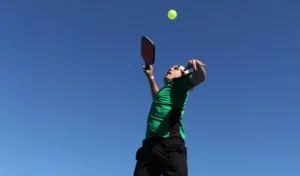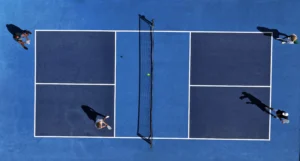
Choosing the best pickleball paddle can impact a person’s performance in the game. If one wants the best paddles for beginners, intermediates, or professionals, making the right choice is necessary. With many products available in the market, how does one determine which pickleball paddle suits their playing style? This guide is created to help new and veteran players learn the various features of pickleball paddles and make a good choice to improve their game.
How to Choose the Best Pickleball Paddle
When selecting a pickleball paddle, some crucial things to remember are weight, grip size, material, and shape. Let’s take each one in turn to see why it is important.
Overview of Key Paddle Factors
| Factor | Description |
|---|---|
| Weight | It affects swing speed, power, and control. |
| Grip Size | Impacts comfort and wrist movement. |
| Material | Determines durability, power, and feel. |
| Shape | It influences the size of the sweet spot and overall playability. |
Paddle Weight: Light, Medium, or Heavy?
The paddle’s weight is one of the most important factors to consider, as it impacts your control, power, and stamina during play. Pickleball paddles typically fall into three weight categories: Whether you’re looking for the best pickleball paddles to match your level, understanding the weight categories can help you decide.
- Lightweight (6.7 – 7.3 ounces): Lightweight paddles are easier to maneuver and are great for players who prioritize control and agility. They are among the best pickleball paddles for intermediate players looking to improve their power. They help you react faster at the net and reduce strain on your arm.
- Midweight (7.3 – 8.4 ounces): Midweight paddles balance power and control. These paddles suit most players, especially those who want a well-rounded game.
- Heavyweight (8.5 – 9.5+ ounces): Heavyweight paddles offer more power but less control. These paddles are great for players who like to hit strong shots but may cause arm fatigue if used for long periods.
Weight Categories of Pickleball Paddles
| Weight Category | Weight Range (oz) | Benefits | Drawbacks |
|---|---|---|---|
| Lightweight | 6.7 – 7.3 | Great control, easy to maneuver | Less power |
| Midweight | 7.3 – 8.4 | Balanced power and control | May not excel in any one area |
| Heavyweight | 8.5 – 9.5+ | High power, solid feel | Less control can lead to arm fatigue |
Grip Size: Comfort and Control
 The grip size of a pickleball paddle is crucial for maintaining control and comfort during play. The wrong grip size can lead to discomfort, poor performance, and even injuries like tennis elbow.
The grip size of a pickleball paddle is crucial for maintaining control and comfort during play. The wrong grip size can lead to discomfort, poor performance, and even injuries like tennis elbow.
- Small Grip (4 – 4.125 inches): Smaller grips allow for more wrist action, making it easier to put spin on the ball. Ideal for players with smaller hands or those who like extra control.
- Medium Grip (4.25 – 4.375 inches): Medium grips are the most common and work well for most players. They offer a good balance between control and stability.
- Large Grip (4.5+ inches): Larger grips provide more stability and are good for players with larger hands. They help reduce wrist movement, which can lead to more consistent shots.
Choosing the Right Grip Size
| Grip Size | Circumference (inches) | Best For |
|---|---|---|
| Small Grip | 4 – 4.125 | Players with smaller hands, more wrist action |
| Medium Grip | 4.25 – 4.375 | Most players, balanced control and comfort |
| Large Grip | 4.5+ | Players with larger hands, more stability |
Tip: If you’re between grip sizes, it’s usually better to go for a smaller grip and add an overgrip if needed. This will give you more flexibility and allow for more wrist action.
Paddle Material: What is the Best Material for Pickleball Paddles?
- Wood: The original paddle material. Wood paddles are durable and inexpensive but tend to be heavy. They are best for beginners who are just getting a feel for the game.
- Composite: Composite paddles are made from materials like fiberglass or carbon fiber, often with a polymer or aluminum core. Composite paddles are often considered among the best pickleball paddles for intermediate players because they offer a good mix of power and control. They offer a good balance of power and control, making them a popular choice for players of all levels.
- Graphite: Graphite paddles are lightweight and provide excellent control and responsiveness. They are often preferred by players looking for the best pickleball paddle for spins, as they offer great precision. They are often preferred by more experienced players who value finesse and precision.
Paddle Material Comparison
| Material | Benefits | Drawbacks | Best For |
|---|---|---|---|
| Wood | Durable, inexpensive | Heavy, less control | Beginners, casual play |
| Composite | Balanced power and control, lightweight | Can be more expensive than wood | All levels, versatile play |
| Graphite | Lightweight, high control and precision | Typically more expensive | Experienced players, precision |
Paddle Shape: Standard vs. Elongated
Paddles come in different shapes, which can impact your gameplay in subtle but important ways:
- Standard Shape: The standard paddle shape is 8 inches wide and 15.5 inches long. The shape has a big sweet spot and is suitable for most players.
- Elongated Shape: Elongated paddles are narrower and longer. They are often considered some of the best pickleball paddles for advanced players, offering extra reach for aggressive play. This extra reach can be beneficial for players who like to play aggressively at the net or those who need a bit more coverage.
- Wide Body: Wide body paddles are slightly wider than standard paddles, offering a more prominent sweet spot and more forgiving hits, ideal for beginners.
Paddle Shapes and Benefits
| Shape | Dimensions | Benefits | Best For |
|---|---|---|---|
| Standard | 8″ x 15.5″ | Larger sweet spot, balanced play | Most players |
| Elongated | Narrower, longer | Extra reach, aggressive play | Advanced players, net play |
| Wide Body | Wider shape | Large sweet spot, forgiving | Beginners, casual players |
How to Test a Paddle Before Buying
If possible, testing a paddle before purchasing is a good idea. Many clubs and sporting goods stores have demo paddles that you can try. Here’s what to look for when testing a paddle:
- Weight: Does the paddle feel comfortable in your hand? Does it feel too heavy or too light?
- Grip Comfort: Make sure the grip feels secure and comfortable in your hand. You should be able to maintain control without excessive squeezing.
- Balance: Swing the paddle a few times. It should feel balanced, and you should be able to control it easily.
FAQs About Choosing a Pickleball Paddle
How to choose best pickleball paddles for intermediate players?
The top pickleball paddles for intermediate players tend to be midweight, offering a balance of power and control. Composite paddles are an excellent option since they are versatile and offer better maneuverability. If you’re looking for the top beginner pickleball paddles, beginning with a midweight composite paddle is a good starting point before moving on to graphite models.
How to choose best pickleball paddles for advanced players?
For professional players, the top pickleball paddles tend to have graphite or extended paddles as they are lightweight with high precision and long reach. They enable better accuracy and aggressive net play, which makes them perfect for strategic players who play a fast-paced game. In case you have been asking yourself which pickleball paddles are suitable, then graphite paddles are a top recommendation for professional and advanced players.
What is the ideal weight for a pickleball paddle?
The ideal weight of a pickleball paddle varies with your playing style. Light paddles (6.7–7.3 oz) add control and enable rapid reactions, which are excellent for players seeking finesse. Heavy paddles (8.5–9.5+ oz) add power, which suits players who enjoy powerful baseline shots. Midweight paddles (7.3–8.4 oz) provide a compromise between power and control, which suits both intermediate and advanced players.
How do I determine what grip size I need?
Grip size is vital for control and comfort. Less wrist action comes with a smaller grip (4 – 4.125 inches), which is ideal for those who prefer putting spin on the shot. Most common is the medium grip (4.25 – 4.375 inches), which has a balance between stability and control. A bigger grip (4.5+ inches) is better suited for those who like to have less wrist action and more consistency in shots. If you are curious what the best material for pickleball paddles is, grip comfort also varies on the core material of the paddle.
What is the best material for pickleball paddles?
If you are inquiring what the best material for pickleball paddles is, the response is based on your skill level and playing style. Graphite paddles are light and provide great control, so serious players choose them first. Composite paddles (fiberglass or carbon fiber) have both power and durability, which is why they are one of the best pickleball paddles to start with. Wood paddles are cheap but heavy and less popular among avid players.
Does paddle shape matter at all?
Yes! Paddle shape plays a major role in the game. Longer paddles have greater reach, which is a plus for aggressive net players and players who enjoy greater coverage. All-around paddles (8″ x 15.5″) have a greater sweet spot and are a great paddle for all-around play. Wide-body paddles have an even larger sweet spot and are one of the best starter pickleball paddles because they are more forgiving on off-center hits.
Can I use a wood paddle as I improve?
Wood paddles are affordable and perfect for beginners, but most players move on to composite or graphite paddles for increased control, power, and lightness. If you’re debating which pickleball paddles are ideal, a transition from wood to a midweight composite paddle is an excellent step before moving to an advanced graphite paddle.
Find the Perfect Paddle and Elevate Your Game
Choosing the right pickleball paddle comes down to weight, grip size, material, and shape—all specifically designed for your game. Whether you want power, control, or a little of both, a paddle is available to suit your requirements.


